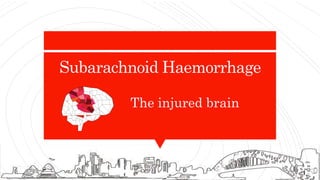
Update on delayed cerebral ischaemia
- 1. Subarachnoid Haemorrhage The injured brain
- 3. Brain Injury Hyper acute phase Acute phase Post acute phase
- 4. Early brain injury Mechanical effects Systemic effects Cellular events
- 7. Cellular events ⬆️ Apoptosis & unplanned cell death ⬆️ Hypoxia-inducible factor 1∝ Biochemical Inflammatory Haemostatic Increased permiability
- 8. Delayed brain injury > 72 hours Complications of critical illness Complications associated with haemorrhagic stroke Delayed cerebral ischaemia
- 13. Summary Brain injury in SAH may be characterized as early or delayed Understanding the link between the two is the key to new treatments and improving outcomes
Editor's Notes
- Thanks for the introduction and invitation to talk today In this short talk I would like to introduce the concept of early and late brain injury in subarachnoid haemorrhage and look at the future for managing this catastrophic condition
- SAH is typically due to a ruptured aneurysm although it may be traumatic and non aneurysmal Classically presents with a thunderclap headache or a sudden loss of consciousness It has an annual incidence of 100 cases per million population which means we see around 500 cases a year in Sydney It most commonly occurs in people aged 40-60 so although it is only about 5% of total strokes it has a disproportionate impact from an individual, social and economic perspective. It is also more common in women although the reasons for this are not well understood.
- It is useful from a pathophysiology perspective to separate brain injury into three different phases whilst acknowledging the obvious overlap Hyper-acute phase is generally the first 72 hours after ictus The acute phase is from day 3-21 And the post acute phase is beyond 21 days – this is actually my research interest in SAH which is trying to work out what outcomes are most important to SAH survivors and their families – but today I am just going to focus on the first two phases which relate to critical care management
- 5
- There are also well documented systemic effects of SAH. There is probably an excessive sympathetic response leading to cardiac strain and occasionally takotsubos cardiomyopathy and subsequent pulmonary complications such as pulmonary oedema and ARDS. There is also a not well understood systemic inflammatory response which may cause multiple organs to become impaired similar to other inflammatory conditions such as infection or pancreatitis. Managing these systemtic effects that often contribute to brain injury is challenging, there is some weak evidence to support the use of betablockers but this requires better designed trials before it may be adopted into practice more widely
- There is a broad range of postulated mechanisms associated with early brain injury and I could have filled this page with a lot more text. I have selected a couple to touch on. HIF 1 alpha accumulated rapidly when there is tissue ischaemia and then goes on to modify the an extensive range of protein transcriptions and may be directly related to planned and unplanned cell death Haemoglobin scavenges nitric oxide which along with the release of endothelin may drive macrovascular and microvascular constriction Thrombin is also activated which may drive micro-thrombosis
- Critical Illness Infections Nutrition, glycaemic control Critical illness weakness Electrolyte disturbances especially sodium dysregulation Venous thromboembolism Haemorrhagic stroke Seizures Rebleeding Hydrocephalus Delirium
- Delayed cerebral ischaemia is the area of most research interest. DCI is a defined clinically as a new focal deficit or drop in GCS by 2 points for more than an hour that isn’t explained by another cause such as hydrocephalus. It is defined radiologically as new cerebral infarction not present after 48 hours or due to procedural complications. Nimodipine remains the only pharmacological agent widely used and the mechanism for its action is unclear. What causes this new injury to the brain? And therefore what are the possible therapeutic targets?
- The term cortical spreading depolarization (CSD) describes a wave of mass neuronal depolarization associated with net influx of cations and water. In SAH it has been observed that these depolarizations can occur in clusters related to structural brain injury and it is thought that this might cause cortical spreading ischaemia to tissues and be a mechanism of DCI There are a range of potential treatments targeting this mechanism one being ketamine which is currently recruiting
- Microthrombosis and associated microconstriction has been found on multiple autopsy series in the region where delayed brain injury has occurred. Furthermore patients with SAH are often in a hypercoagulable state and this is a probable mechanism for DCI There are have been some previous small studies of anti-platelet drugs in SAH which have not demonstrated currently multiple trials looking at a range of coagulation modifying drugs such as anti=platelets, heparin and fibrinolytics.
- Angiographic vasospasm is much more common in SAH patients who develop DCI It is easily measurable and therefore it is the best studied and most often treated target to reduce DCI Unfortunately in the best design studies which reduced vasospasm did not change the incidence of DCI therefore the casual relationship has been questions we still use therapies such as hypertensing patients vasospasm and although this was subject to a recent trial the study terminated early without a conculsive result. Other therapies include treating with via interventional radiology with localized calcium channel blockers.
